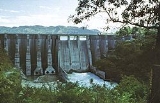
Péligre Hydroelectric Dam
Encyclopedia
The Péligre Dam is a hydroelectric dam located off the Centre Department
on the Artibonite River
of Haiti
. It is the largest dam on the island of Hispaniola
consisting of Haiti and the Dominican Republic
.
The dam was created as a flood-control and an energy-providing measure in the Artibonite river valley as part of the Artibonite Valley Agricultural Project in the 1930s. The dam was completed in 1956 thus creating Lake Péligre
(essentially a large reservoir
) in the process. The Peligre Hydroelectric Plant and its consequent operation was completed in 1971. The plant situated on the dam provides the country with most of its needed electricity.
Recently, spanning over the last few decades, a rapid rate of silt deposition has occurred in the Peligre Reservoir reducing the energy producing capability of the reservoir. The sedimentation is in large part due to the deforestation
that has been plaguing the country over the years.
The power plant, though needed, has fallen into near disrepair. The EDH (Électricité d'Haïti), Haiti's federal electricity supplier, has done relatively little to restructure the plant however. As of current, the hydroelectric potential is estimated to be around 173 megawatts. Electricity production, though lacking in many areas, is increasing in part due to the repairs being made on the dam and the establishment of several other electrical plants.
Centre Department
Centre is one of the ten departments of Haiti, located in the center of the country, along the border with the Dominican Republic. It has an area of 3,675 km² and a population of 564,200 . Its capital is Hinche. It borders the Dominican Republic to the east. It is the only landlocked...
on the Artibonite River
Artibonite River
The Artibonite River is a 320 km long river in Haiti . It is the longest as well as the most important river in Haiti and the longest on the island of Hispaniola. Forming part of the international border between Haiti and the Dominican Republic, the river's sources are in the Cordillera Central in...
of Haiti
Haiti
Haiti , officially the Republic of Haiti , is a Caribbean country. It occupies the western, smaller portion of the island of Hispaniola, in the Greater Antillean archipelago, which it shares with the Dominican Republic. Ayiti was the indigenous Taíno or Amerindian name for the island...
. It is the largest dam on the island of Hispaniola
Hispaniola
Hispaniola is a major island in the Caribbean, containing the two sovereign states of the Dominican Republic and Haiti. The island is located between the islands of Cuba to the west and Puerto Rico to the east, within the hurricane belt...
consisting of Haiti and the Dominican Republic
Dominican Republic
The Dominican Republic is a nation on the island of La Hispaniola, part of the Greater Antilles archipelago in the Caribbean region. The western third of the island is occupied by the nation of Haiti, making Hispaniola one of two Caribbean islands that are shared by two countries...
.
The dam was created as a flood-control and an energy-providing measure in the Artibonite river valley as part of the Artibonite Valley Agricultural Project in the 1930s. The dam was completed in 1956 thus creating Lake Péligre
Lake Péligre
Lake Péligre is the second largest lake in Haiti, and is located in the Centre Department. Tracy Kidder describes it as "beautiful, blue waters set among steep, arid mountains"....
(essentially a large reservoir
Reservoir
A reservoir , artificial lake or dam is used to store water.Reservoirs may be created in river valleys by the construction of a dam or may be built by excavation in the ground or by conventional construction techniques such as brickwork or cast concrete.The term reservoir may also be used to...
) in the process. The Peligre Hydroelectric Plant and its consequent operation was completed in 1971. The plant situated on the dam provides the country with most of its needed electricity.
Recently, spanning over the last few decades, a rapid rate of silt deposition has occurred in the Peligre Reservoir reducing the energy producing capability of the reservoir. The sedimentation is in large part due to the deforestation
Deforestation
Deforestation is the removal of a forest or stand of trees where the land is thereafter converted to a nonforest use. Examples of deforestation include conversion of forestland to farms, ranches, or urban use....
that has been plaguing the country over the years.
The power plant, though needed, has fallen into near disrepair. The EDH (Électricité d'Haïti), Haiti's federal electricity supplier, has done relatively little to restructure the plant however. As of current, the hydroelectric potential is estimated to be around 173 megawatts. Electricity production, though lacking in many areas, is increasing in part due to the repairs being made on the dam and the establishment of several other electrical plants.

